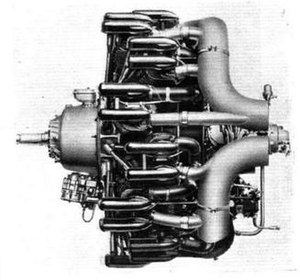The Armstrong Siddeley Leopard was a British 14-cylinder twin-row air-cooled radial aero engine developed in 1927 by Armstrong Siddeley. It was the most powerful radial engine in the world when introduced.[1]
| Leopard | |
|---|---|

| |
| Type | Radial engine |
| National origin | United Kingdom |
| Manufacturer | Armstrong Siddeley |
| First run | 1927 |
Variants
edit- Leopard I
- 700 hp, medium supercharged. Direct drive propeller.
- Leopard II
- 700 hp, geared epicyclic drive.
- Leopard III
- 800 hp, two-valve cylinder head, direct drive.
- Leopard IIIA
- 800 hp, geared epicyclic drive.
Applications
editSpecifications (Leopard I)
editData from Lumsden, 2003.[5]
General characteristics
- Type: 14-cylinder twin-row air-cooled radial engine
- Bore: 6.0 in (152.4 mm)
- Stroke: 7.5 in (190.5 mm)
- Displacement: 2,970 cu in (48.6 L)
- Length: 60.85 in (1546 mm)
- Diameter: 58 in (1473 mm)
- Dry weight: 1,466 lb (665 kg)
Components
- Valvetrain: Overhead valve, four valves per cylinder
- Fuel type: Petrol
- Cooling system: Air-cooled
Performance
- Power output: 700 hp (522 kW) at 1,650 rpm at sea level
- Compression ratio: 5.00:1
- Fuel consumption: 45 gal/hr (169 L/hr) at cruise speed
- Power-to-weight ratio: 0.47 hp/lb
See also
editComparable engines
Related lists
References
editNotes
editBibliography
edit- Lumsden, Alec. British Piston Engines and their Aircraft. Marlborough, Wiltshire: Airlife Publishing, 2003. ISBN 1-85310-294-6.
- Mason, Francis K. Hawker Aircraft since 1920 (third ed.). London: Putnam, 1991. ISBN 978-0-8517-7839-6.
- Smith, Herschel. Aircraft Piston Engines. New York, New York: McGraw-Hill, 1981. ISBN 0-07-058472-9.